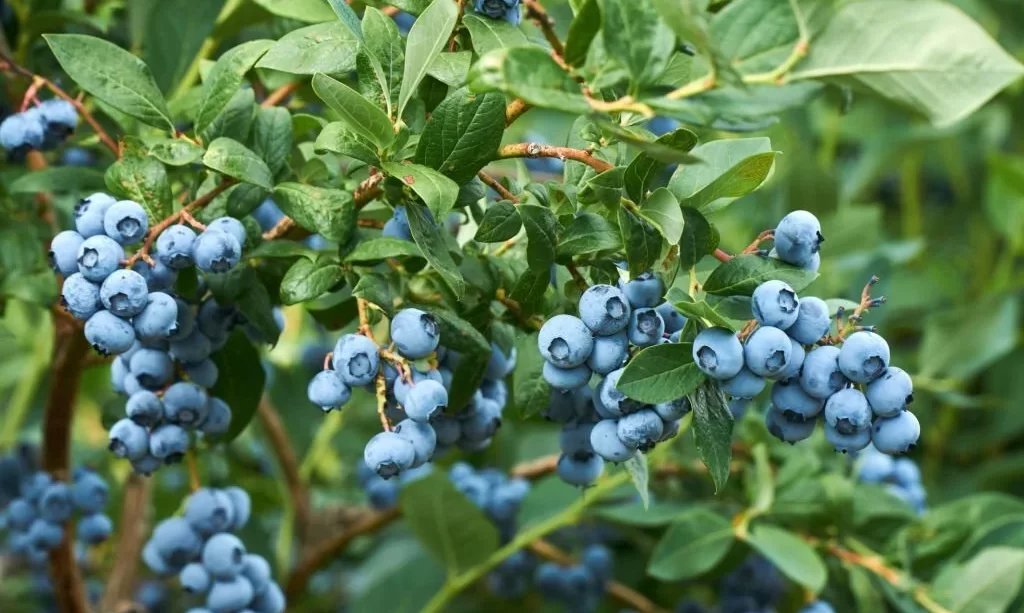If you’re a blueberry enthusiast or simply want to expand your garden with these delicious berries, learning how to propagate blueberry bushes can be a rewarding endeavor. Propagation is the process of creating new plants from existing ones, and in the world of blueberries, it’s a great way to multiply your berry bounty without breaking the bank. In this article, we’ll guide you through the surprisingly simple art of blueberry propagation. Whether you’re a beginner or a seasoned gardener, you’ll discover two primary methods: stem cuttings and layering. These methods open the door to a world of blueberry bushes, allowing you to enjoy more of these sweet, tangy delights in your own backyard.
- 🌿 live 1 gallon Tifblue blueberry bush comes with easy to use blueberry food and produces Round, ripe berries every june-july (needs another variety to pollinate and produce fruit)
- 🌞 This Bush features outward-spreading branches with light-green foliage and pink to White blossoms before Berry production
- 💙 This plant loves the sun and would enjoy a spot in the landscape that receives full sun throughout the day
- 🐬 mature Height: 3-15ft | mature width: 3-10ft, blueberries respond well to pruning if a specific height is desired
- 🌟 Tifblue blueberry is a heavy blueberry producer compared to other varieties — Tifblue berries hold a tart potency until fully ripe when they take on a juicy-sweet flavor
Types of Blueberry Propagation
Before you roll up your sleeves and get your hands dirty, it’s important to understand the two main types of blueberry propagation: stem cuttings and layering.
Stem Cuttings: Stem cuttings involve taking a piece of a healthy blueberry bush and encouraging it to grow roots, essentially creating a clone of the parent plant. This method is straightforward and ideal for those who want to propagate multiple plants from one source. Stem cuttings are usually taken in late spring or early summer when the blueberry bush is actively growing. They can be a quick and efficient way to expand your blueberry garden.
Layering: Layering is a method where a portion of a blueberry bush’s stem is buried in the soil while still attached to the parent plant. This buried stem section will develop roots, and eventually, you can cut it from the parent to create a new plant. Layering is a bit slower than stem cuttings, but it’s incredibly reliable and requires minimal care. It’s an excellent choice for those who prefer a more hands-off approach to propagation or want to propagate a blueberry bush that’s already mature.
In the sections that follow, we’ll delve into the step-by-step details of each of these blueberry propagation methods, so you can choose the one that best suits your gardening style and goals. Whether you opt for stem cuttings or layering, the result will be a thriving blueberry bush ready to reward you with delicious berries in due time.
Gathering Supplies
Before you embark on your blueberry propagation journey, it’s essential to gather the necessary supplies. Here’s what you’ll need:
- Pruning Shears: To take stem cuttings, you’ll require sharp pruning shears or scissors. Make sure they are clean and in good condition to make clean cuts.
- Rooting Hormone: This is a powder or gel that encourages the development of roots on your blueberry cuttings. It’s readily available at garden centers.
- Pots or Containers: You’ll need small pots or containers for planting your cuttings. These should have drainage holes to prevent waterlogging.
- Potting Mix: Get a well-draining potting mix suitable for blueberries or make your own by combining peat moss and perlite.
- Plastic Bags or Domes: Transparent plastic bags or domes will create a humid environment for your cuttings, aiding in root development.
- Watering Can or Spray Bottle: You’ll need a gentle way to water your cuttings without disturbing them.
- Labels and Marking Pen: To keep track of your blueberry varieties, use labels and a marking pen to identify each cutting or plant.
- Parent Blueberry Plant: Ensure you have a healthy and disease-free parent blueberry bush to take cuttings from.
With these supplies in hand, you’re ready to start propagating blueberry bushes using stem cuttings.
- MAKE PRUNING WORK EASIER: Rust-resistant stainless steel blade are sharp and durable for easy and smooth cut.Anti-slip and ergonomic handle make the gardener clippers more comfortable in your hand.Easy-open spring action reduces hand fatigue while cutting. you can easily to cut without damaging the vital stems and branches of your plants.
- User-FRIENDLY SAFETY LOCK:These garden shears have locking mechanisms to keep the sharp blades securely closed when not in use.It is easy to maneuver and can effectively reduce accidental injuries.
- GARDEN GLOVES: This Gardening gloves,made of soft & comfortable cotton fabric,can protect yourself from dirt, skin wounds and nasty splinters when doing yard chores. The grip latex coating provides anti-slip or sure control when grabbing garden & yard tools.
- COMFORTABLE HANDLE: The handle part of the pruning shears made by high-purity PP+TPR plastic, especially the hand grip is very comfortable, but also has strong toughness and strength.
- PACKING LISTING: The packing include pruning shear, fruits shear, flower cutter, leaves trimmer, one pair glove, one organizer bag.Those pruning shears could satisfy need of planting, harvesting, floral, indoor and outdoor planting, greenhouse pruning.
Propagating Blueberries from Stem Cuttings
Propagating blueberries from stem cuttings is a straightforward process. Here are the steps to follow:
- Select the Right Branches: Identify healthy, disease-free branches on your parent blueberry plant. These should be about 4-6 inches long and have several sets of leaves.
- Take the Cuttings: Use clean pruning shears to snip the selected branches just below a leaf node. Each cutting should have at least two sets of leaves.
- Remove Lower Leaves: Trim off the leaves from the lower half of the cutting, leaving only the top sets of leaves intact.
- Apply Rooting Hormone: Dip the cut end of each cutting into rooting hormone to encourage root growth.
- Plant the Cuttings: Insert the cuttings into pots filled with moist potting mix. Plant them about 2 inches deep, with the leafy end above the soil.
- Create a Mini Greenhouse: Cover the pots with clear plastic bags or domes to create a humid environment. This helps prevent moisture loss and encourages root development.
- Place in Indirect Light: Put the pots in a location with indirect sunlight to prevent overheating. Avoid direct sunlight, as it can scorch the cuttings.
- Maintain Moisture: Keep the potting mix consistently moist but not waterlogged. Use a spray bottle or a gentle watering can to avoid disturbing the cuttings.
- Monitor Growth: Check for root development by gently tugging on the cuttings after a few weeks. If you feel resistance, roots are forming.
- Transplanting: Once the cuttings have developed a good root system, usually in a few months, transplant them into larger pots or directly into your garden.
Stem cuttings can be a rewarding way to multiply your blueberry bushes. Be patient and diligent in caring for your cuttings, and soon you’ll have new blueberry plants to enjoy in your garden.
Propagating Blueberries by Layering
Layering is another effective method for propagating blueberry bushes. Here’s how you can do it:
- Select a Healthy Branch: Choose a low, flexible branch from your parent blueberry bush. This branch will become the new plant.
- Prepare the Branch: About a foot from the tip of the selected branch, make a small, shallow cut or scrape away a small section of bark. This is where roots will form.
- Bury the Branch: Dig a shallow trench in the ground near the parent plant. Gently bend the prepared branch down into the trench, ensuring the scraped section is covered with soil.
- Secure the Branch: Use garden staples or weights to hold the bent branch in place. Leave the tip of the branch sticking out of the soil.
- Water and Mulch: Water the buried section of the branch thoroughly and cover it with mulch to help retain moisture.
- Wait for Rooting: Over the next several months, the buried section of the branch will develop roots. You can check for root growth by carefully digging up a small portion of the branch without disturbing it too much.
- Separate and Transplant: Once the branch has a healthy root system, carefully cut it from the parent plant and transplant it to its new location in your garden.
Caring for Propagated Blueberry Plants
After successfully propagating your blueberry plants, it’s crucial to provide them with proper care to ensure their growth and fruit production. Here are some essential care tips:
- Watering: Blueberries need consistent moisture, especially during dry periods. Keep the soil evenly moist but not waterlogged. Use a soaker hose or drip irrigation to water deeply without wetting the foliage.
- Mulching: Apply a layer of organic mulch, such as pine straw or wood chips, around the base of your blueberry plants. Mulch helps retain moisture, suppress weeds, and regulate soil temperature.
- Fertilizing: Blueberries benefit from acidic soil. Use a specialized blueberry fertilizer or one designed for acid-loving plants. Follow the recommended application rates, typically in spring.
- Pruning: Prune your blueberry bushes annually during the dormant season (late winter to early spring). Remove dead or weak branches and thin out crowded growth to improve air circulation.
- Protect from Birds: Blueberries are a favorite snack for birds. Consider using bird netting or scare tactics like reflective tape to protect your ripening berries.
- Sunlight: Ensure your blueberry plants receive at least 6-8 hours of direct sunlight each day for optimal fruit production.
- Pest and Disease Management: Keep an eye out for common pests like aphids and diseases like powdery mildew. Treat any issues promptly with appropriate organic or chemical remedies.
- Harvesting: Blueberries are ready for harvest when they are fully ripe and have a deep color. Gently pick them by hand to avoid damaging the delicate berries.
By following these care guidelines, your propagated blueberry bushes will thrive and reward you with a bountiful harvest of delicious blueberries year after year.
Troubleshooting Common Issues
While propagating blueberry bushes can be a rewarding experience, it’s not without its challenges. Here are some common issues you might encounter and how to address them:
Wilting Cuttings or Layers
- Cause: Excessive heat or sunlight can cause cuttings or layers to wilt.
- Solution: Move them to a cooler, shadier spot and ensure they are adequately hydrated.
Yellowing Leaves
- Cause: Yellowing leaves may indicate nutrient deficiencies, usually iron or nitrogen.
- Solution: Apply a specialized blueberry fertilizer that addresses these deficiencies according to package instructions.
Fungal Infections
- Cause: Damp conditions can lead to fungal diseases like gray mold or root rot.
- Solution: Improve air circulation, avoid overwatering, and use fungicides as a last resort.
Slow Root Development
- Cause: Cuttings or layers may take longer to root in cooler temperatures.
- Solution: Be patient and maintain a stable environment with adequate moisture.
Pest Infestations
- Cause: Aphids, mites, or other pests can harm young plants.
- Solution: Use insecticidal soap or neem oil to control pests and regularly inspect your plants.
- Lowers Soil pH
- High Quality Sulfur Formulated for Blueberry Bush
- Palletized for controlled release
- add 3/4 pound of sulfur per 100 square feet
Conclusion
Congratulations! You’ve now learned how to propagate blueberry bushes using both stem cuttings and layering techniques. Whether you prefer the speed of stem cuttings or the reliability of layering, you have the tools to expand your blueberry garden. Remember that patience is key when propagating blueberries, as it may take several months for your new plants to establish themselves fully.
By gathering the right supplies, following the step-by-step instructions, and providing proper care, you can enjoy the satisfaction of growing your own blueberry bushes. These delicious berries will not only enhance your garden but also provide a source of fresh, homegrown goodness for years to come.
So, roll up your sleeves, get your hands dirty, and watch your blueberry bushes flourish as you embark on this exciting journey of propagation.







